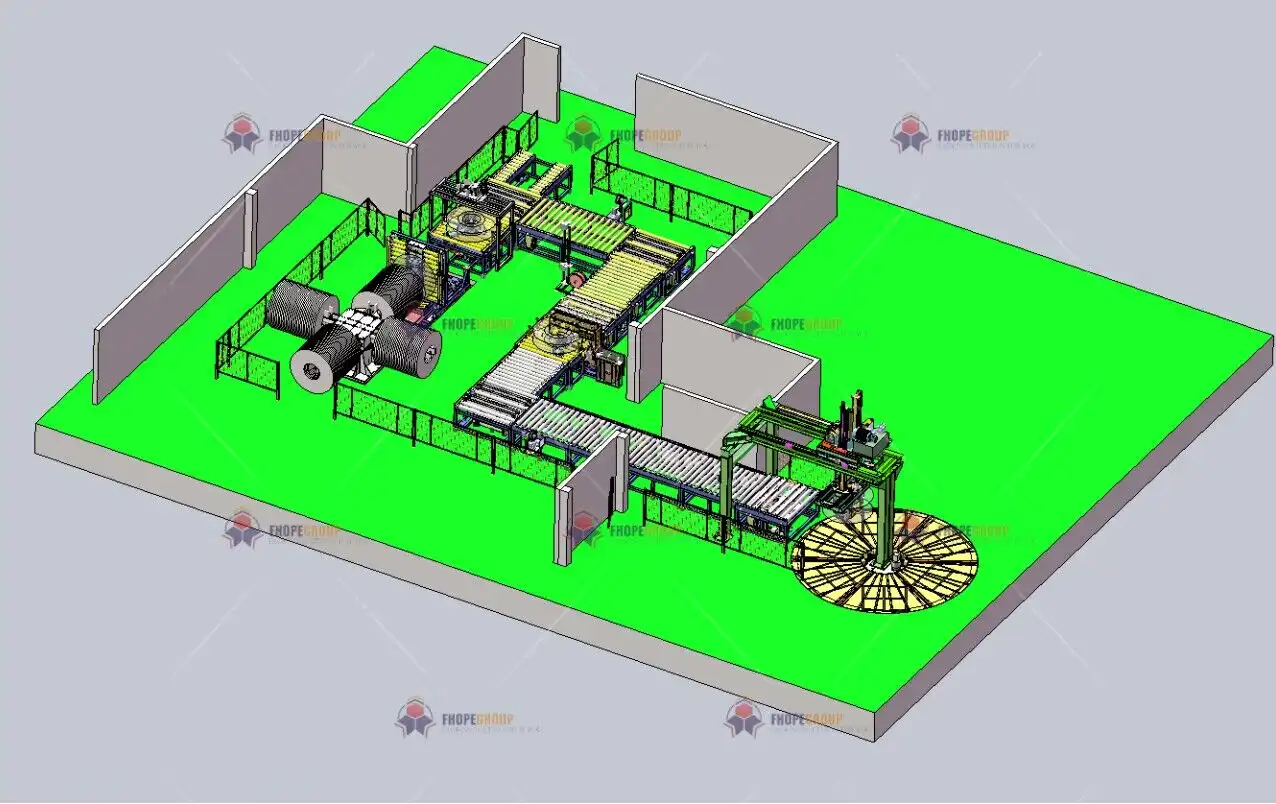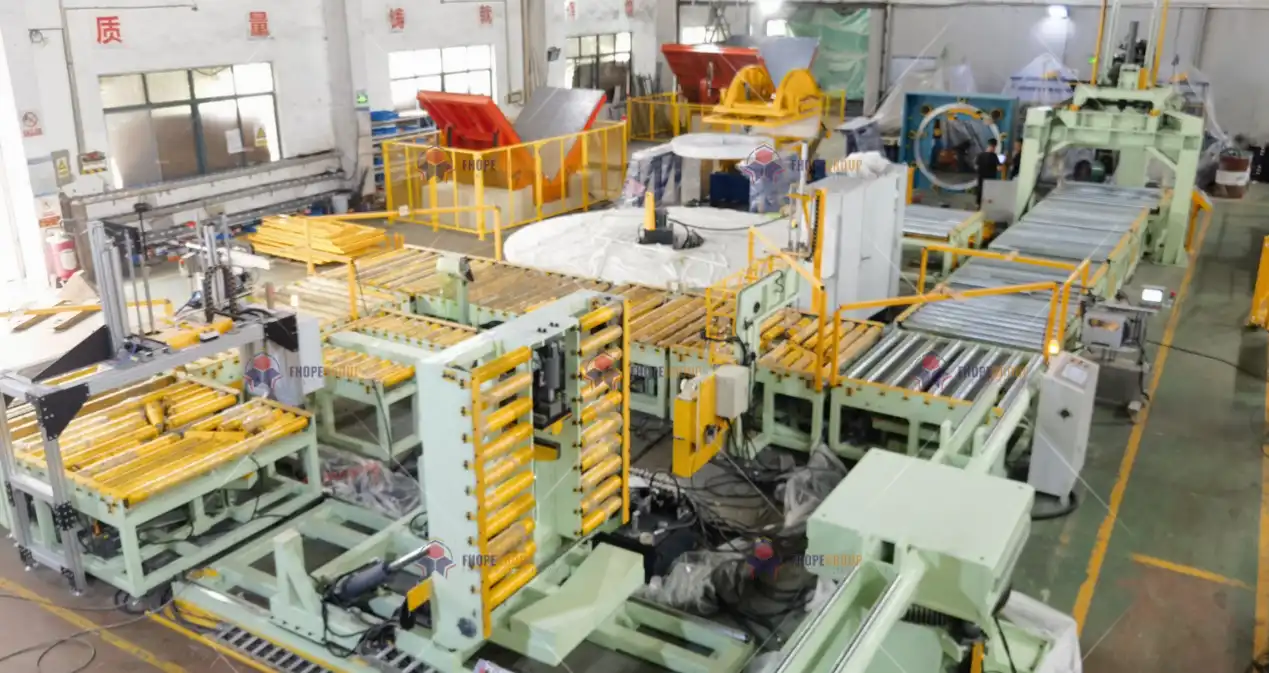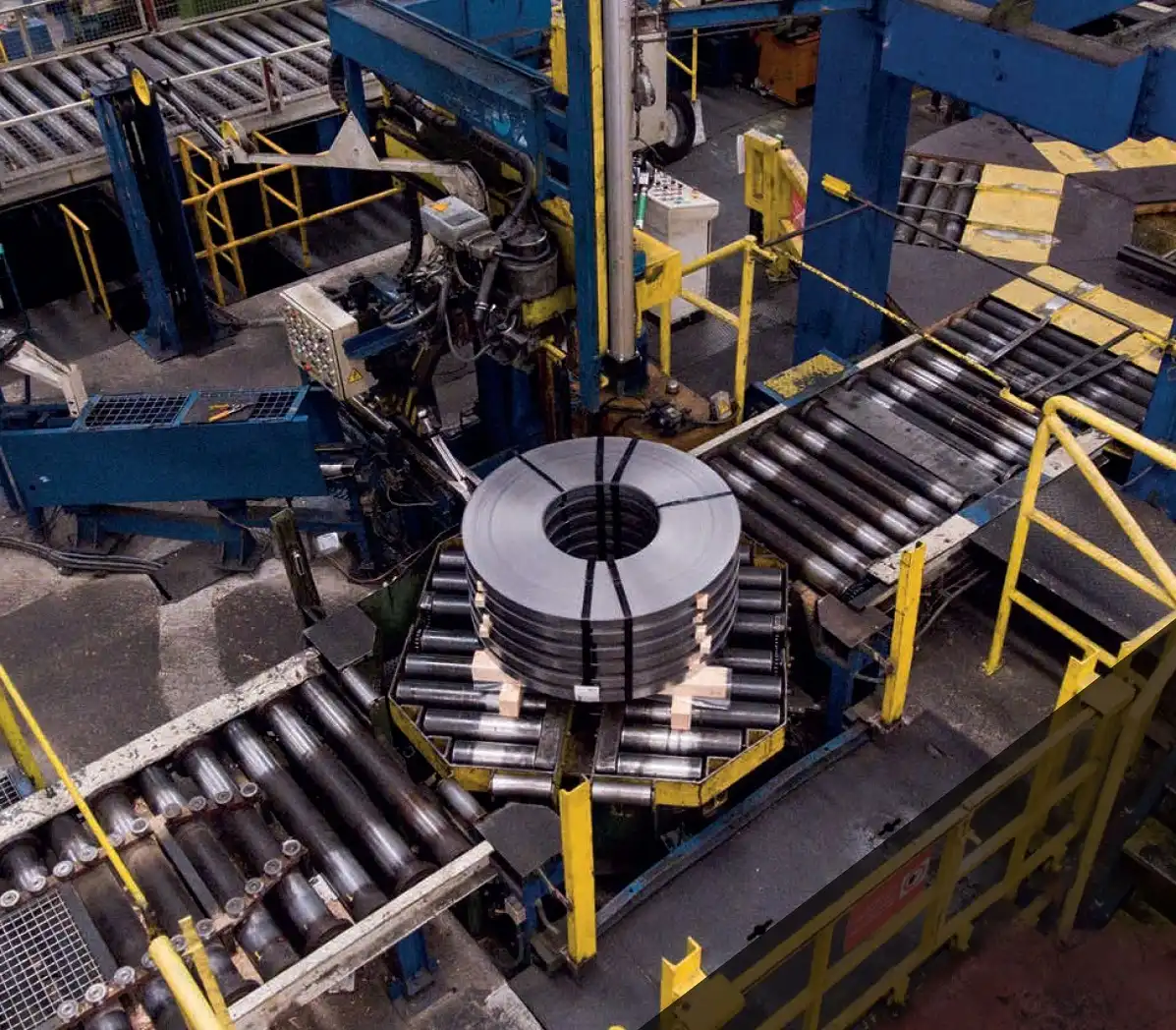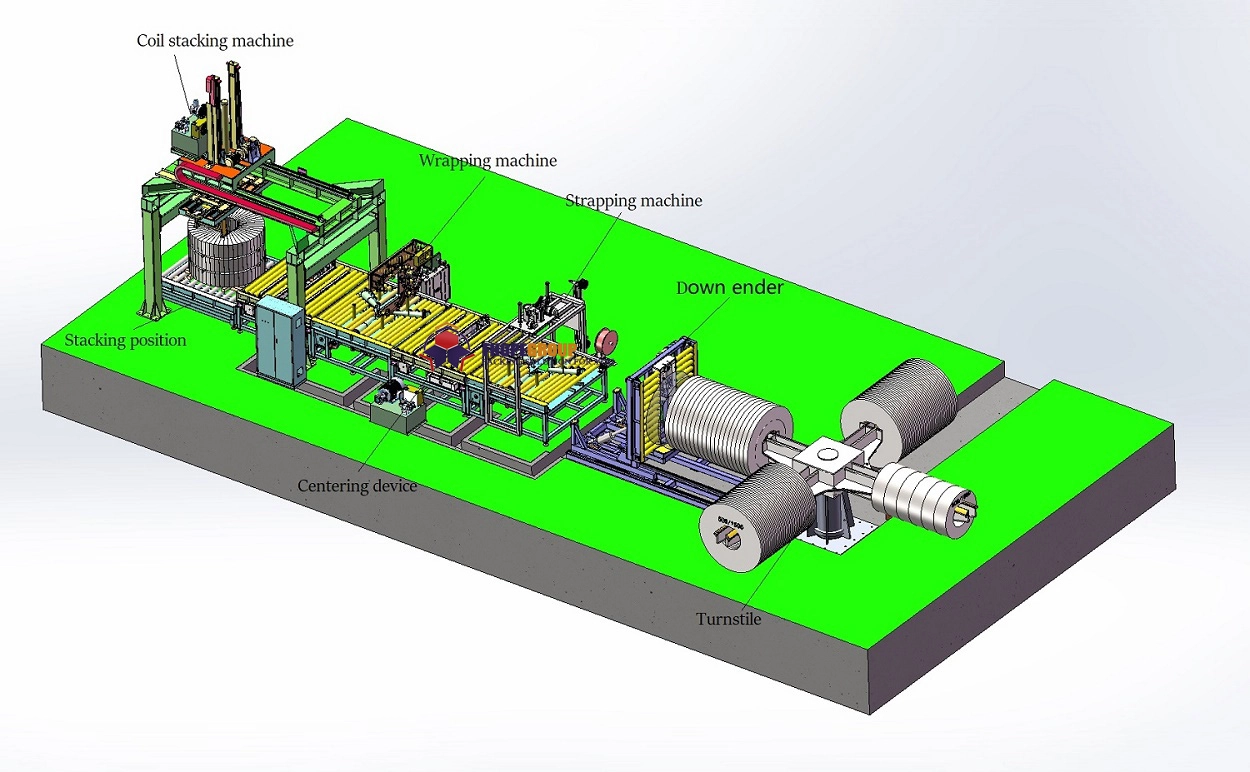Your slit coil packing line is the final, critical step before your product ships. So when it stops unexpectedly in your Indonesian facility, everything grinds to a halt. Production targets are missed, shipping schedules are delayed, and customers are left waiting. Every minute of downtime bleeds money and damages your hard-won reputation. You know some of your equipment is aging, and navigating the complexities of maintenance in a market like Indonesia can feel overwhelming. The solution isn’t a single magic bullet. It’s a carefully blended strategy, combining smart technology with practical, on-the-ground execution. I've built my career on finding these solutions, and I’ve seen them transform operations from chaotic to consistently reliable.
The most effective way to minimize downtime on slit coil packing lines in Indonesia is by implementing a hybrid maintenance strategy. This approach combines data-driven predictive maintenance (PdM) for critical, high-cost components with a disciplined preventive maintenance (PM) schedule for standard wear parts. This is supported by proactive, operator-led routine checks. This integrated system ensures maximum equipment reliability and uptime while keeping maintenance costs under control and tailored to the local operating environment.

This hybrid model sounds powerful in theory. But what does it actually look like in a busy steel mill? How do you apply these principles to a packing line that has been running for over a decade in a specific environment like Indonesia? It’s about more than just buying new software or creating a schedule. It requires a shift in mindset. I want to share what I've learned over my entire career, from my first days as an engineer on the factory floor to establishing my own factory. My goal at SHJLPACK isn't just to sell machines; it's to share knowledge. I want to give you the practical, actionable insights you need to make your operations more stable, efficient, and profitable. Let's break down how you can build a maintenance system that truly works.
How Can Predictive Maintenance (PdM) Outperform Preventive Maintenance for Indonesian Steel Mills?
You follow a strict preventive maintenance schedule, replacing key parts on your packing line every six months like clockwork. You invest in the parts and the labor, yet you still suffer from unexpected breakdowns that bring production to a standstill. This is a frustrating and costly cycle. You are spending money on components that may still have plenty of life left in them, while other surprise failures continue to cripple your line. Your goal of reaching 95% equipment uptime feels impossible when you’re constantly reacting to problems you thought you had prevented. The answer is to shift from a calendar-based approach to a condition-based one. Predictive maintenance allows you to use data to fix parts right before they fail, saving money and dramatically reducing the unplanned downtime that hurts your bottom line.
Predictive Maintenance (PdM) outperforms Preventive Maintenance (PM) for Indonesian steel mills because it relies on real-time data from sensors to forecast failures before they happen. Instead of replacing parts on a fixed schedule, this data-driven approach allows for "just-in-time" repairs. This maximizes the useful lifespan of every component, cuts spending on unnecessary spare parts, and nearly eliminates costly unplanned downtime, which is absolutely essential for achieving high capacity utilization targets in a competitive market.

The Core Difference: Time vs. Condition
Preventive maintenance (PM) operates on a fixed schedule. You change the oil every 5,000 kilometers, whether it's dirty or clean. This is simple, but often inefficient. Predictive maintenance (PdM) is like a blood test for your machine. It analyzes the actual condition of the equipment to decide when service is needed. Think of the "bathtub curve" for equipment failure. Some parts fail early due to manufacturing defects, while others fail late in life from wear and tear. PM, being time-based, is not very effective at catching these. It replaces parts in the middle of their useful life, often needlessly. PdM, however, monitors the condition continuously, so it can detect the subtle signs of both early-life and end-of-life problems, allowing you to intervene at the perfect moment.
Key Technologies for PdM on a Slit Coil Line
Implementing PdM is not about filling your machine with every sensor possible. It's about strategically choosing the right tools for the most critical components. For a slit coil packing line, especially in a warm, demanding climate like Indonesia's, a few key technologies provide the most value.
| Technology | What it Monitors on a Packing Line | Benefit in Indonesian Context |
|---|---|---|
| Vibration Analysis | Bearings, motors, gearboxes on conveyors and strapping heads. | Detects tiny imbalances and wear long before they become catastrophic failures. This is the single most important tool for rotating machinery. |
| Thermal Imaging | Electrical panels, motor connections, hydraulic pumps. | Identifies overheating components that signal a fire risk or imminent failure. This is especially useful in Indonesia's warm ambient temperatures. |
| Oil Analysis | Hydraulic power units, large gearboxes. | Checks for metal particles, water, or chemical breakdown in lubricants. It helps you protect expensive components and extend oil change intervals safely. |
| IoT Sensors | Strapping head tension, conveyor speed, cycle counters. | Provides a continuous stream of operational data to your MES or a cloud platform, enabling advanced analytics and building a digital twin of your process. |
The Business Case for PdM
As a business owner, you need to see the return on investment. The case for PdM is compelling because it directly addresses your key goals. It lowers operating costs because you stop throwing away good parts. It increases capacity utilization because you replace unplanned downtime with short, planned maintenance windows. It also supports your digital transformation goals by generating valuable data that helps your team make smarter, faster decisions. I remember a client in Jakarta who ran their packing line 24/7. They switched from a rigid 6-month PM schedule on their strapping heads to using vibration sensors. They discovered that some heads needed service after just four months of heavy use, while others ran perfectly for over a year. Their unplanned packing line downtime dropped by over 70% in the first year, and their spare parts budget for strapping heads was cut nearly in half. This is the real-world impact of data-driven maintenance.
What Role Do Local Technicians and Spare Parts Availability Play in Indonesia's Uptime?
You have invested in the most advanced predictive maintenance system. Your sensors send alerts, and your platform tells you exactly which bearing is about to fail. But the replacement part is sitting in a warehouse in Germany or China, and it will take three weeks to clear customs in Jakarta. Your high-tech system is now completely useless. The production line is stopped, your team is idle, and you feel powerless as you wait for a shipment. This scenario is a nightmare for any plant manager, but it is a common reality in many parts of the world, including Indonesia. The ultimate solution to downtime is not just technology, but a robust local support system. This means having well-trained local technicians who can act immediately and a smart inventory of critical spare parts stored right there in your facility.
In Indonesia, local technicians and the ready availability of spare parts are the most critical factors for maintaining high uptime on slit coil packing lines. A well-trained local maintenance team can perform immediate diagnostics and repairs, turning a potential week-long shutdown into a fix that takes only a few hours. This capability, combined with a local inventory of essential parts, completely eliminates the long shipping and customs delays from overseas suppliers, which is the single biggest bottleneck in breakdown recovery.

Building a Skilled Local Maintenance Team
The most reliable machine in the world will fail if it isn't maintained by people who understand it. Your equipment supplier should be your partner in building this local expertise. When we at SHJLPACK deliver a machine, we see the training as being just as important as the hardware. This training shouldn't be a one-time event. It should be an ongoing process that includes hands-on coaching during commissioning and access to online resources and remote support afterward.
A key part of this is empowering your machine operators through a concept called Autonomous Maintenance. This means training operators to perform daily checks, cleaning, lubrication, and simple adjustments. This does two things: it catches small problems before they become big ones, and it fosters a deep sense of ownership among your team. When operators feel responsible for their equipment, they treat it better. This also frees up your more skilled technicians to focus on complex troubleshooting, predictive maintenance analysis, and improvement projects, rather than routine tasks.
Smart Spare Parts Management
You cannot afford to stock every single part for your packing line; the cost would be enormous. The key is to be strategic. You need to analyze your equipment and classify parts based on their importance and lead time. This allows you to create a smart inventory strategy that balances cost and risk.
| Part Category | Description | Stocking Strategy in Indonesia | Example |
|---|---|---|---|
| Critical Spares | Failure causes immediate line stoppage. Very long lead time to acquire. | Stock at least one unit locally on-site. The cost of downtime is far greater than the cost of the part. | Main strapping head assembly, master PLC, main drive motor. |
| Wear Parts | Parts that are consumed regularly with predictable life. | Stock locally based on historical consumption rates and PdM data. Order more when you reach a set minimum level. | Strapping cutters and grippers, feed wheels, conveyor belts, fuses. |
| Standard Parts | Components that can be easily sourced from local industrial suppliers in Indonesia. | Do not stock. Create a list of local suppliers and part numbers. Buy as needed. | Standard-size bearings, bolts, pneumatic fittings, some sensors. |
| Capital Spares | Extremely expensive components that rarely fail. | Do not stock locally. Rely on your equipment supplier's regional warehouse (e.g., in Singapore) or their central factory stock. | Main machine frame components, very large gearboxes. |
The Supplier's Role as a Partner
A good supplier doesn't disappear after they've been paid. A true partner works with you to ensure your long-term success. They should actively help you develop this spare parts strategy. When we work with a client like you, we provide a detailed recommended spares list, categorized exactly like the table above. We offer training programs for your local technicians, both online and in-person, in the local language whenever possible. This is what we mean by our slogan, "TOTAL SOLUTION FOR WRAPPING MACHINE." It’s a commitment to support your entire operation, not just the machine itself.
Can Digitalization and IoT Really Cut Maintenance Costs on a Slit Coil Line?
You constantly hear the buzzwords: "Digitalization," "IoT," "Industry 4.0." They are presented as the future of manufacturing, promising incredible efficiency gains. But these concepts can also sound incredibly expensive and complicated. You worry about the high initial investment in sensors, software, and integration. Will it actually deliver the promised cost savings, or will it become just another complex system that your team struggles to use effectively? The risk of a poor return on investment is a major concern for any pragmatic business leader. The secret is to avoid trying to do everything at once. You should start small and focus on high-impact applications. When applied correctly, digital tools can provide clear, measurable reductions in maintenance costs and a direct path to the higher profitability you are aiming for.
Yes, digitalization and IoT can absolutely cut maintenance costs on a slit coil packing line. By deploying targeted sensors and a central data platform, such as your Manufacturing Execution System (MES), you enable the shift from costly reactive maintenance to proactive, predictive maintenance. This allows you to optimize your spare parts inventory, reduce unnecessary labor, and enable remote diagnostics from experts anywhere in the world. These benefits directly reduce your spending on labor and parts and, most importantly, slash the massive costs associated with unplanned production downtime.

From Data to Actionable Insights
The biggest mistake I see companies make is collecting huge amounts of data without a clear plan for how to use it. A dashboard full of numbers is not useful. The goal is to turn data into clear, actionable instructions. A well-designed IoT system doesn't just show you that a motor's temperature is 85°C. It should automatically trigger an alert to the maintenance manager's phone that says, "Packing Line Motor C3 temperature is 15% above its normal operating range for the last 30 days. Recommend inspection during the next scheduled stop." This turns a data point into a specific work order. When this system is connected to your Computerized Maintenance Management System (CMMS), it can automatically schedule the work, order the necessary parts, and ensure the task is completed. This is where real efficiency is gained.
Practical IoT Applications on a Packing Line
You don't need a massive, multi-million dollar project to start seeing benefits. You can begin with a few high-impact applications that address your most common problems.
| IoT Application | How It Works | Impact on Maintenance Costs |
|---|---|---|
| Remote Diagnostics | We equip our machines with a secure remote access module. With your permission, our engineers at SHJLPACK can log into your machine's PLC and HMI from our office. | This drastically reduces the need for expensive and slow on-site service calls for troubleshooting. We find we can diagnose and resolve over 80% of software or control-related issues remotely within minutes. |
| Cycle Counting | A simple sensor counts every time the strapping head applies a strap. | This data allows you to trigger maintenance based on actual usage, not just time. A work order for a head rebuild can be set for every 500,000 cycles, ensuring you get maximum life from wear parts without risking failure. |
| Energy Monitoring | Simple power meters are installed on the main motors of the packing line to track kilowatt-hour (kWh) consumption per coil packed. | This directly supports your goal of lowering unit energy consumption. It helps you identify inefficient operations or a failing component (like a bad bearing) that is drawing more power than it should. |
The Financial Payback
As a CEO, you need to see the numbers. The ROI for these projects is often much faster than people expect. The initial cost includes the sensors, any necessary software, and the labor for installation and integration. The savings come from multiple areas: fewer breakdowns (avoiding lost production revenue), fewer emergency repairs (which means no overtime labor or rush shipping fees for parts), less waste from replacing parts too early, and lower travel costs for external technical support. Let me give you a simple, conservative calculation. If one day of unplanned downtime on your packing line costs your business $50,000 in lost contribution margin, and a $20,000 investment in an IoT monitoring system prevents just one single day of downtime in its first year, the system has already paid for itself more than twice over. From my experience, the savings are usually much, much greater.
Is Upgrading Old Packing Lines More Cost-Effective Than a Full Replacement?
Your 15-year-old slit coil packing line is becoming a constant source of headaches. Breakdowns are more frequent, finding spare parts for the obsolete control system is a challenge, and it doesn't have any of the modern data capabilities you need for your digital transformation goals. A full replacement is a massive capital expense that will require a complex approval process and a long installation shutdown. But continuing to patch up the old machine feels like throwing good money after bad. You are caught in a difficult position between a huge investment and ongoing operational pain. Often, the most pragmatic and cost-effective path forward is not one of these extremes, but a strategic upgrade. This involves keeping the solid mechanical foundation of your machine and retrofitting it with modern components and technology.
For many packing lines that are over 15 years old, a strategic upgrade, or retrofit, is significantly more cost-effective than a full replacement. By focusing investment on the highest-impact systems—typically the strapping head, the PLC controls, and the safety system—you can achieve 80% of the performance and reliability of a brand-new machine. This approach usually comes at a fraction of the cost of a full replacement and, just as importantly, can be completed with significantly less installation downtime, getting you back into production faster.

When to Upgrade vs. When to Replace
The decision to upgrade or replace is not always obvious. It requires a careful and honest assessment of your existing equipment and your future business needs. I always advise my clients to analyze a few key factors to make the right data-driven decision.
| Factor | Favorable for a Strategic Upgrade | Favorable for a Full Replacement |
|---|---|---|
| Mechanical Frame | The core steel structure is sound, with no major cracks, corrosion, or fatigue. The foundation is solid. | The main frame is heavily fatigued, corroded, or has been damaged. The fundamental structure is compromised. |
| Throughput Needs | Your current mechanical speed (coils per hour) is sufficient for your production targets. The bottleneck is reliability, not speed. | You need a significant increase in packing speed that the current machine's mechanical design simply cannot achieve. |
| Key Issues | The problems are mostly isolated to specific components like an obsolete PLC, unreliable sensors, or a high-maintenance strapping head. | You have widespread mechanical wear in conveyors, hydraulics, turntables, and other structural elements. The problems are everywhere. |
| Budget | You have a limited capital expenditure (CapEx) budget but a reasonable operational expenditure (OpEx) budget. | You have sufficient CapEx approved for a major, long-term strategic investment in new technology. |
| Downtime Window | You need a solution that can be implemented quickly, perhaps during a short, planned annual shutdown. | You can afford a longer shutdown period (often several weeks) for removal of the old line and installation of the new one. |
The Anatomy of a High-Impact Upgrade
If you decide an upgrade is the right path, the key is to focus your investment where it will make the biggest difference. You don't need to change everything. A successful retrofit targets the "brain" and "heart" of the machine.
- The Strapping Head: This is the heart of any packing line. It is the most complex component and often the biggest source of downtime. Replacing an old, worn-out mechanical head with a modern, high-efficiency model is the single best upgrade you can make. New heads are faster, more reliable, require less maintenance, and often use less strapping material.
- The Control System: This is the brain. Replacing an obsolete PLC, HMI screen, and motor drives with a modern system from a major brand like Siemens or Allen-Bradley is crucial. This not only improves reliability but also gives you the platform you need for data collection, remote access, and integration with your plant's MES.
- The Safety System: Safety standards have evolved significantly. Upgrading to modern light curtains, safety-rated PLCs, and locking door switches is not just about compliance; it's about protecting your people. It also reduces nuisance trips from older, less reliable safety components.
My Experience with a Retrofit Project
This approach delivers real results. I worked with a steel mill in Southeast Asia that had a German-made packing line from the late 1990s. The heavy steel frame was still in excellent condition, but the control system was obsolete, and their maintenance team spent hours every week trying to keep the complex strapping head running. They couldn't justify the cost of a brand-new line. We proposed a strategic retrofit. We replaced their old head with one of our modern SHJLPACK models and installed a completely new Siemens PLC control cabinet with a new HMI. We also added a remote access module for diagnostics. The entire on-site project was completed in just one week during their planned annual shutdown. It cost them about 30% of what a new line would have. They gained the performance, data capability, and reliability of a modern machine without the massive cost and disruption of a full replacement. For them, it was the perfect strategic choice.
My Personal Insights as a Factory Owner
Javier, I've read about your background. You started as a team leader and built a 2-million-ton steel mill. I have deep respect for that journey, because I have walked a similar path. I started as a young engineer on a factory floor, learning how these machines work, and eventually took the risk to build my own company. People like us understand what it means to be responsible for every machine, every employee, and every dollar of profit.
Your challenges—volatile energy costs, aging equipment, intense market pressure—are not unique to Mexico. I see them with my clients in every corner of the world, including Indonesia. But your stated goal to find a "strategic partner" instead of just a supplier is what tells me you understand the real key to success.
A supplier sells you a machine. A partner helps you solve your problem. The best maintenance strategy to minimize your downtime isn't about buying the most expensive technology or the newest machine. It's about building a complete system of people, processes, and technology that works for your specific operation, in your specific market.
My advice, from one factory owner to another, is simple:
- Trust Your People: Invest in training and empowering your local Indonesian team. They are your first, best, and fastest line of defense against downtime. Give them the tools and knowledge they need to win.
- Be Smart with Data: Don't just collect data to make fancy charts. Use it to make one small, better decision every single day. That is how you achieve a goal like lowering overall operating costs by 8%. It happens incrementally.
- View Your Equipment Supplier as Part of Your Team: A partnership is a two-way street. Challenge your suppliers. Ask them for a detailed spare parts strategy. Ask for a multi-year training plan. Demand excellent remote support. If all they want to do is send you a quote for a box, they are not the right partner for you.
I built SHJLPACK on this exact philosophy. The packaging machine industry gave me the opportunity to achieve financial independence and build something lasting. My mission now is to share what I've learned to help other leaders like you succeed. Because when your mill runs more efficiently and your business grows, we all benefit.
Conclusion
Minimizing downtime in Indonesia requires a smart mix of predictive technology, local team empowerment, and strategic upgrades. The right partner helps you build this complete system for long-term success.





